
Do Other Oceans Display Oscillations?
ENSO REMAINS THE GREATEST CAUSE of climatic variability on a global scale, but oscillations have been identified in other ocean basins and shown to have regional impacts. Whether these phenomena are linked or “coupled” with ENSO is still debated, but they may be responsible for long-term variations in our climate. One such oscillation occurs in […]

What Connects Equatorial Atmospheric and Oceanic Circulation?
EQUATORIAL AND TROPICAL REGIONS are areas of greatest excess energy. The interaction of ocean and atmosphere systems there have great implications for climate and its variability in other parts of the world. In the same way that the Hadley cells establish connections between latitudes, there are large-scale, east-west connections within the equatorial atmosphere-ocean system. These […]

How Are the Atmosphere, Oceans, and Cryosphere Coupled?
THE SURFACE OF THE OCEANS marks the boundary between Earth’s major systems — oceans and atmosphere. Both systems move mass and energy laterally and vertically, primarily in response to variations in density and to the equator-to-pole energy gradient. Deep-flowing abyssal waters are generally cooler and denser than surface waters, but they rise in some places […]

What Processes Affect Ocean Temperature and Salinity in Tropical and Polar Regions?
THE EXTREMES IN SEAWATER TEMPERATURE AND SALINITY occur at high and low latitudes. The warmest and most saline waters occur in the tropics and subtropics, while very cold, less saline waters occur near the poles, away from where ice is actively forming. Here, we examine the processes occurring in some of the warmest and coldest […]
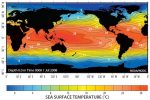
What Are the Global Patterns of Temperature and Salinity?
THE OCEANS VARY IN SALINITY from place to place and with depth. Spatial variations are due to differences in the amount of evaporation and formation of ice, which increase salinity, versus the amount of precipitation, input from streams, and melting of ice, all of which add fresh water that dilutes the salinity. Also, saline waters […]

What Causes Water to Rise or Sink?
MOVEMENT WITHIN THE OCEANS arises from other factors in addition to shearing induced by the wind. Such factors include variations in the density of water in response to changes in its temperature and salinity. Changes in temperature and salinity occur from flows of fresh water into and out of the oceans as a result of […]
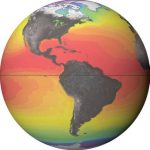
How Do Sea-Surface Temperatures Vary from Place to Place and Season to Season?
SEA-SURFACE TEMPERATURES (SST) VARY GREATLY, from bathwater warm to slightly below freezing. Early data on SST were collected from ships, but since the 1970s, satellites have collected voluminous SST data, documenting variations in temperature from region to region, season to season, and decade to decade. SST data have become even more important as climatologists investigate […]

What Is the Global Pattern of Surface Currents?
CONCEPTUAL MODELS OF REALITY, like the pole-to-pole ocean on the previous page, help us to draw general conclusions about the operation of physical processes. They also serve to highlight locations, or physical conditions under which the simplified overriding ideas prove inadequate in explaining observed phenomena. The global figure below depicts a summary of major surface […]
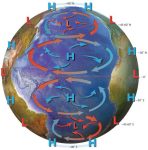
What Causes Ocean Currents?
SURFACE WATER OF THE OCEANS circulates in huge currents that generally carry warmer water toward the poles and colder water toward the equator. Extremely large quantities of energy are stored in the uppermost 100 meters of the global oceans, and surface ocean currents redistribute this energy from one part of the ocean to another, carrying […]

Atmosphere-Ocean-Cryosphere Interactions
OVER 70% OF THE PLANET'S surface is covered by oceans, which exchange energy and moisture with the overlying atmosphere. Oceans move in response to three main factors — winds moving over the top of them, spatial variations in the density of water, and the Coriolis effect. In addition to responding to wind directions, oceans in […]
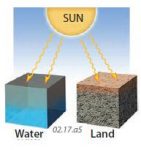
Why Do Temperatures Vary Between Oceans and Continents?
WATER EXHIBITS VERY DIFFERENT thermal properties from those displayed by the rocks and soil of land. These differences in thermal properties cause oceans and land to warm and cool at different rates, leading to significant temperature variations between oceans and land. Such differences help explain major patterns of global temperature and climate. How Do Water […]
The Birth of an Ocean
Even today, the geology of this desert caught between Africa and Eurasia remains dynamic. For instance, the Earth's crust is splitting apart along the long, narrow gash of the Red Sea, which runs between the Arabian Desert and Northern Africa. The gaps between Africa and Eurasia began opening 35 million years ago along the 1,600-mile […]
The “Blueberries” That Predicted an Ocean
The Great Basin Desert harbors enigmatic sandstone marbles that have already helped prove that Mars once had oceans. The geological mystery story starts on the Red Planet, where the robot rover Opportunity went trundling across the surface looking for signs of water and beamed back to Earth images of perplexing stone nodules, perfectly round rocks […]
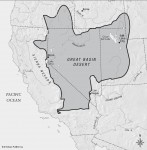
Adapted to the Sagebrush Ocean
The Great Basin Desert harbors far fewer species than the warm, summer-rain-blessed Sonoran Desert to the south. Only a handful of flowers like the plains daisy and the yellow parsley bloom in the spring. Only a handful of birds, notably the horned lark, flit through its expanses. Horned larks account for almost all the flocks […]
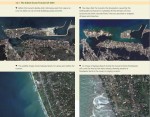
The Indian Ocean Tsunami of 2004
One of the most dangerous side effects of tectonic activity is the tsunami—a great ocean wave produced by an undersea earthquake or volcanic explosion. When a tsunami arrives at a coastline, it causes a temporary and rapid rise of sea level. Ocean waters rush landward and surge far inland, destroying coastal structures and killing inhabitants. After some minutes, the waters retreat, continuing […]
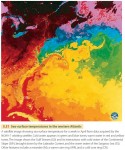
Ocean Circulation
Just as there is a circulation pattern to the atmosphere, there is also a circulation pattern to the oceans that it is driven by differences in density and pressure acting along with the Coriolis force. Pressure differences are created in the water when the ocean is heated unequally, because warm water is less dense than cold water. These pressure differences induce […]
Oceans of Conflict and Imagination
Overriding these turns to the ocean across the various subdisciplines of human geography are two increasingly prevalent geographies of the ocean: the construction of the ocean as a site of conflict and its construction as a space of imagination. The rise of the ocean as a site of conflict is a direct result of its dominant management paradigm, wherein specific zones […]
Economic Geographies of the Sea
Finally, economic geographers as well are beginning to direct their attention to the ocean. Countless local and national economies are driven by the tourism sector and, within the tourism sector, a wide range of activities involve tourists embracing the ocean, whether from the shore, a ship, the surface, or beneath the waves. Economic gain is also constructed in the ocean […]
Environmental Geographies of the Sea
Just as historically there has been little cultural geography of the sea, similarly few human geographers until recently have focused on the ocean as a space of nature. To some extent, this likely is because, until recently, it was believed that humans could do little to influence the condition of the marine environment or the status of marine resources. Prior […]
Cultural Geographies of the Sea
While contemporary studies of the political geography of the sea can draw upon a long history of political geographers studying maritime conflict, the study of marine issues is quite new in cultural geography. Of course, there always have been marine cultural geographies; seafaring and fishing communities invariably display distinct cultural formations that reflect and impact the surroundingmarine environment. Historically, […]
Political Geographies of the Sea
Historically, when human geographers have studied the ocean, they most often have looked to the sea as a space of politics and, in particular, as an arena for geopolitical conflict. The ocean has been viewed as a space in which the forces of land based states meet as each attempts to control crucial areas of the sea (e.g., choke points […]
Emergent Geographies of the Sea
These epistemological shifts, in turn, have led to new areas of research in the human geography of the ocean. In the remainder of this section, four areas of human geography are reviewed: political, cultural, environmental, and economic geographies of the sea.
A Sea Change in Epistemology
In recent decades, each of these barriers to human geographic research on the ocean has been challenged by broad reaching shifts in social thought. Turning first to the barrier of state centrism, since the 1970s the rise of globalization studies has led to the emergence of a number of perspectives that challenge the prevailing view of the world as a […]

Oceans
The Forgotten 71% Oceans cover 71% of the Earth's surface and contain 97% of the planet's water. Over 20% of the world's petroleum is derived from offshore sources and 95% of world trade by weight, or two thirds by value, is carried by ship. Eighty percent of the world's fish catch comes from the ocean, supporting the livelihoods of 140 […]

Pacific Ocean
THE PACIFIC OCEAN HAS an area of approximately 68,767,000 square mi (178,106,000 square km) with its adjacent seas; 65,329,000 square mi (169,202,000 square km) without them. As the world's largest ocean, it has the following characteristics. Volume: 160,489,000 cubic mi (674,052,000 cubic km) including adjacent areas; 158,065,000 cubic mi (663,871,000 cubic km) if they are […]
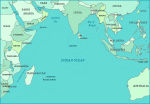
Indian Ocean
MEASURING approximately 26.5 million square mi (68.5 million square km), the Indian Ocean includes the Andaman Sea, ARABIAN SEA, BAY OF BENGAL, Flores Sea, Great Australian Bight, Gulf of Aden, Gulf of Oman, Java Sea, Mozambique Channel, PERSIAN GULF, RED SEA, Savu Sea, Straits of Malacca, Timor Sea, and other tributary water bodies. The ocean […]
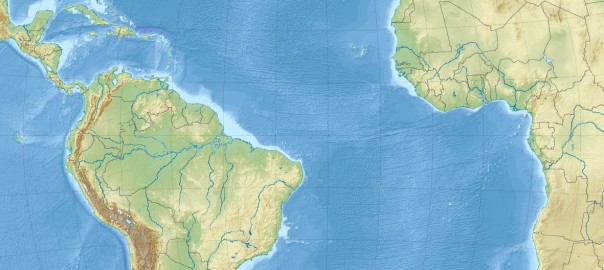
Atlantic Ocean
THE NAME OF THE Atlantic Ocean is derived from the Greek god Atlas and means “Sea of Atlas.” Its area is approximately 41 million square mi (106 million square km) including its adjacent seas; volume is approximately 85 million cubic mi (354 million cubic km), including adjacent areas. The average depth of the ocean with […]
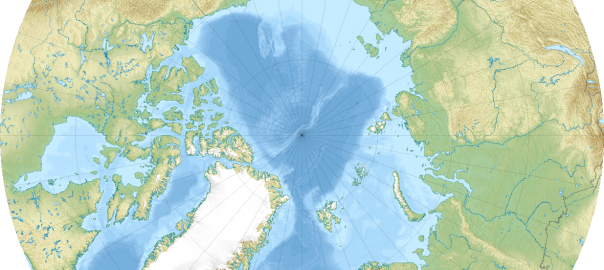
Arctic Ocean
THE ARCTIC is the smallest and shallowest of the Earth's five oceans, occupying 4 percent of the world's ocean space and surrounding the North Pole, the northernmost locale on the planet. The waters of the Arctic are fairly equidistant around the area, making the North Pole the approximate center of the ocean. The majority of […]